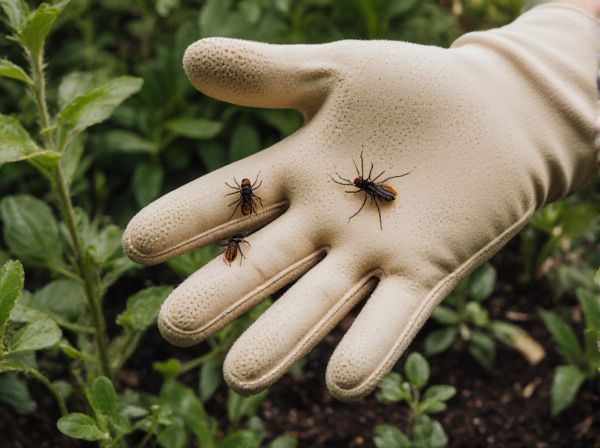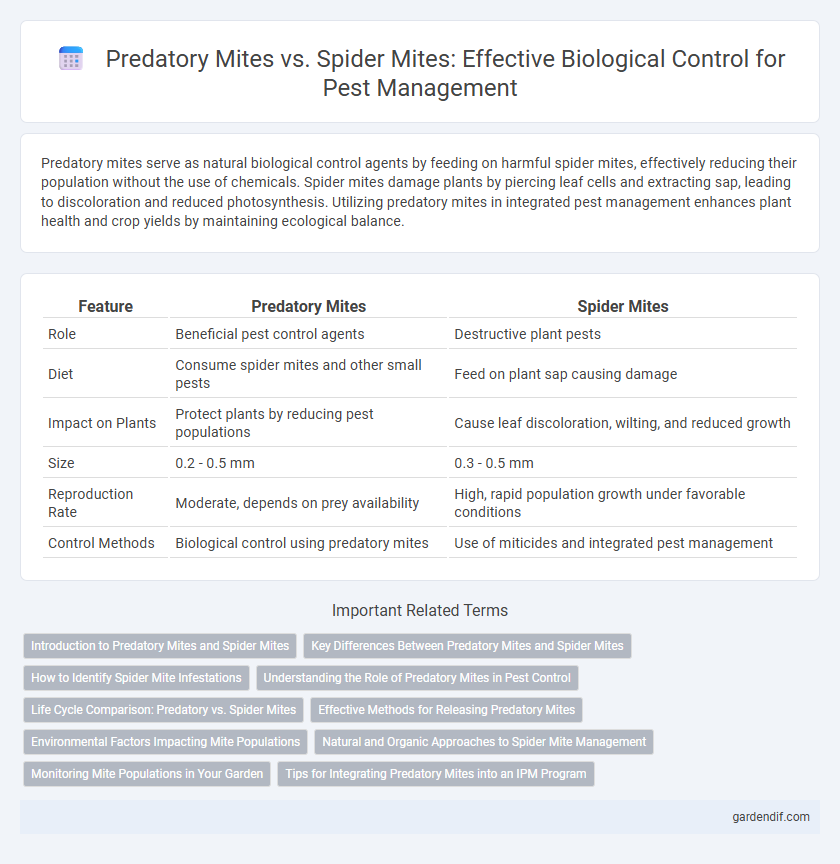
Predatory mites vs Spider mites Illustration
Predatory mites serve as natural biological control agents by feeding on harmful spider mites, effectively reducing their population without the use of chemicals. Spider mites damage plants by piercing leaf cells and extracting sap, leading to discoloration and reduced photosynthesis. Utilizing predatory mites in integrated pest management enhances plant health and crop yields by maintaining ecological balance.
Table of Comparison
| Feature | Predatory Mites | Spider Mites |
|---|---|---|
| Role | Beneficial pest control agents | Destructive plant pests |
| Diet | Consume spider mites and other small pests | Feed on plant sap causing damage |
| Impact on Plants | Protect plants by reducing pest populations | Cause leaf discoloration, wilting, and reduced growth |
| Size | 0.2 - 0.5 mm | 0.3 - 0.5 mm |
| Reproduction Rate | Moderate, depends on prey availability | High, rapid population growth under favorable conditions |
| Control Methods | Biological control using predatory mites | Use of miticides and integrated pest management |
Introduction to Predatory Mites and Spider Mites
Predatory mites, such as Phytoseiulus persimilis, are beneficial arachnids used in biological pest control to manage spider mite populations effectively. Spider mites, including Tetranychus urticae, are harmful pests that feed on plant cells, causing leaf discoloration, webbing, and reduced crop yield. Understanding the biology and interaction between predatory and spider mites is essential for integrated pest management strategies in agriculture.
Key Differences Between Predatory Mites and Spider Mites
Predatory mites are beneficial arthropods that feed on pest insects like spider mites, helping to naturally control their populations. Spider mites are plant pests that damage crops by piercing leaf cells and causing discoloration, typically thriving in hot, dry conditions. Predatory mites are generally larger, faster, and exhibit hunting behavior, whereas spider mites reproduce rapidly and form webbing on infested plants.
How to Identify Spider Mite Infestations
Spider mite infestations can be identified by the presence of tiny, reddish or yellowish spots on the undersides of leaves, along with fine webbing that covers the plant surface. Leaves may exhibit stippling, yellowing, and eventual browning or drying as the mites feed on plant cells. Close inspection often reveals minute, fast-moving spider mites clustered around damaged leaf areas, distinguishing them from predatory mites which are larger and more robust.
Understanding the Role of Predatory Mites in Pest Control
Predatory mites play a crucial role in biological pest control by targeting and consuming spider mites, which are notorious for damaging crops and ornamental plants. These beneficial mites naturally regulate spider mite populations, reducing the need for chemical pesticides and promoting sustainable agriculture. Understanding the interaction between predatory and spider mites helps optimize integrated pest management strategies, enhancing crop health and yield.
Life Cycle Comparison: Predatory vs. Spider Mites
Predatory mites have a shorter life cycle, typically completing development from egg to adult within 7 to 14 days, allowing rapid population growth to control pest mites. Spider mites, such as the two-spotted spider mite, complete their life cycle in about 8 to 12 days under favorable conditions, enabling quick infestations and damage to plants. The contrasting reproductive rates and developmental durations highlight the predatory mite's effectiveness in biologically managing spider mite populations.
Effective Methods for Releasing Predatory Mites
Releasing predatory mites like Phytoseiulus persimilis involves careful timing and environmental control to maximize their pest control efficiency against spider mites. Applying them during early spider mite infestation stages in temperatures between 20-30degC ensures rapid establishment and effective predation. Evenly dispersing predatory mites on the undersides of leaves and maintaining high humidity levels around 60-80% enhances their survival and spider mite suppression.
Environmental Factors Impacting Mite Populations
Predatory mite populations thrive in environments with moderate humidity and stable temperatures, which enhance their ability to control spider mite infestations effectively. Spider mites proliferate rapidly under hot, dry conditions, often leading to severe plant damage if natural predatory mite populations are suppressed. Managing environmental factors such as humidity and temperature can significantly influence the balance between predatory and spider mite populations, improving integrated pest management outcomes.
Natural and Organic Approaches to Spider Mite Management
Predatory mites (Phytoseiidae family) serve as natural biological control agents that effectively reduce spider mite (Tetranychidae family) populations in organic gardening and agricultural systems. These beneficial mites consume spider mites and their eggs, minimizing the need for chemical pesticides and promoting sustainable pest management. Integrating predatory mites with organic practices such as neem oil applications and maintaining plant health enhances spider mite suppression while preserving environmental balance.
Monitoring Mite Populations in Your Garden
Monitoring mite populations in your garden requires regular inspection of leaves, focusing on undersides where spider mites often cluster and predatory mites hunt. Using a magnifying glass, look for webbing, leaf discoloration, or tiny moving dots to distinguish between harmful spider mites and beneficial predatory mites. Implementing sticky traps and maintaining suitable humidity supports effective tracking and control of both mite populations, ensuring pest management precision.
Tips for Integrating Predatory Mites into an IPM Program
Integrating predatory mites into an Integrated Pest Management (IPM) program requires selecting species such as Phytoseiulus persimilis, known for its effectiveness against spider mites like Tetranychus urticae. Ensure optimal environmental conditions with temperatures between 70-85degF and humidity levels above 60% to promote predatory mite activity and reproduction. Regular monitoring and reduced pesticide applications help maintain predatory mite populations, enhancing biological control efficacy against spider mite infestations.
Predatory mites vs Spider mites Infographic

 gardendif.com
gardendif.com